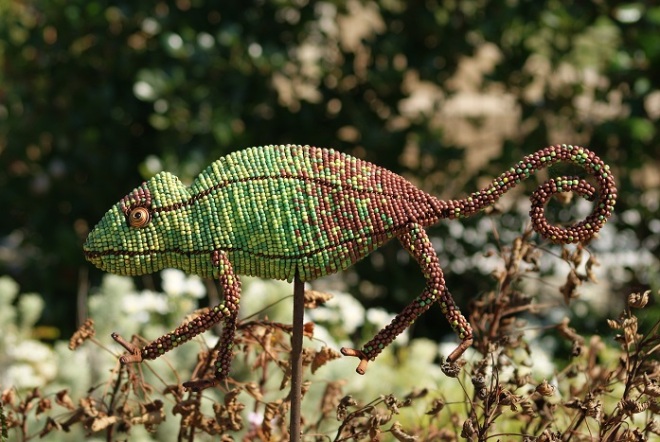This wire sculpture is just about the closest we can get to see a chameleon these days.
To the delight of our children, they were fairly common in our garden when we first arrived in the Eastern Cape. We would see them making their way through the shrubs and dense bushes, and watched in fascination as they changed colour or caught an insect with their incredibly long tongues. Their separately mobile eyes were a marvel to observe too.
I like to think of our garden as being environmentally sound: we use no insecticides or even fertilizers; there is an abundance of indigenous trees, shrubs, grasses, and flowers; plenty of natural cover; a ‘wild’ section which is seldom touched; and water is available at a variety of heights. Still, we have not seen a chameleon here for years.
The Eastern Cape Dwarf Chameleons (Bradypodion ventrale) seems to have disappeared, although I am told they are still around – if one knows where to look.


Dis so hartseer! Mense wat orals gif spuit en alles uitroei wat na ‘n gogga lyk, is die groot sondebokke.
LikeLike
Ek stem saam.
LikeLiked by 1 person
Your garden sounds like a welcoming place for all. I hope the chameleons return!
LikeLike
I hope so too! The prolonged drought we are experiencing must have a detrimental effect on their population.
LikeLike
Sad to read that, Anne. I hope your beaded sculpture draws them back to your garden.
LikeLike
From what we’ve seen already your garden would be a chameleon paradise, Anne. Sadly the biggest threat to chameleons in built up areas are domestic cats.
LikeLike
That is true. The cat population in our suburb waxes and wanes as people arrive and depart over time.
LikeLiked by 1 person
I can really relate to this post. In my childhood, our backyard was full of little chirping sparrows. We also got rare birds – some with beautiful colouring. Now, there is hardly any birdsong to be heard in Delhi. I really miss it. It scares me.
LikeLike
Your experience illustrates so well how important it is to provide a haven for birds in the best way one can in an urban setting. Large populations of people and their various activities drive all wildlife to the fringes.
LikeLike
I remember seeing them in my mother-in-law’s garden in Port Elizabeth many years ago. They are such beautiful and graceful creatures.
LikeLike
This is very sad.
LikeLike
Thank you for stopping by: we keep looking out for chameleons …
LikeLiked by 1 person
I hope that they will return as more and more people start living responsibly.
LikeLike